Gerbil
Gerbil Care 101: Tips & Insights for Owners

Did you know that gerbils are social creatures that communicate through non-verbal cues? These small rodents, originating from Africa, Central Asia, and the Indian subcontinent, are recognized for their playful and inquisitive behavior. If you’re thinking about caring for gerbils, it’s crucial to comprehend their specific requirements and ways to offer them a secure and engaging habitat.
In this article, we’ll share valuable tips and insights to help you become a successful gerbil owner. From understanding their habitat requirements and dietary needs to grooming and handling techniques, we’ve got you covered. So let’s dive in and discover how to ensure the well-being of these adorable creatures.
Key Takeaways:
- Gerbils are social animals that communicate through non-verbal signals.
- Understanding their habitat requirements and providing proper nutrition is crucial for their well-being.
- Building trust and handling gerbils with care is essential for a positive owner-pet relationship.
- Regular grooming and habitat cleaning are necessary to maintain their health and hygiene.
- Creating a stimulating environment with toys and accessories enriches their lives and prevents boredom.
Gerbil Characteristics
When it comes to pet care difficulty, gerbils are an excellent choice for beginners. These small rodents have unique characteristics and needs that make them an enjoyable and low-maintenance addition to any family. Let’s explore some key traits and requirements of gerbils:
-
Average Lifespan: With proper care, gerbils can live up to 5 years, providing years of companionship and joy.
-
Adult Size: Adult gerbils typically reach around 4 inches in length (excluding the tail), making them a compact and easy-to-handle pet.
-
Diet: Gerbils have an omnivorous diet, meaning they eat both plant-based and protein-rich foods. A balanced diet consists of gerbil lab blocks or pelleted food, supplemented with grains, vegetables, and occasional fruits.
-
Habitat Size: To provide gerbils with ample space for exploration and burrowing, it is recommended to have a minimum habitat size of 18” L x 30” W x 12” H. This gives them room to roam, exercise, and exhibit their natural behaviors.
| Gerbil Characteristics | Description |
|---|---|
| Geriatric Lifespan | Up to 5 years |
| Adult Size (excluding tail) | Around 4 inches |
| Diet | Omnivorous with a focus on gerbil lab blocks, grains, vegetables, and occasional fruits |
| Habitat Size | Minimum of 18” L x 30” W x 12” H |
Ensuring that your gerbil has a suitable environment and a balanced diet is crucial in promoting their overall health and well-being. By providing them with the right supplies, such as food, treats, bedding, nesting material, exercise wheel, hideaway place, toys, wood chews, dust bath, and chew tubes, you can create a comfortable and stimulating habitat that supports their natural instincts and behaviors.
Gerbil Habitat
Gerbils need a spacious and comfortable habitat that allows them to run, climb, and explore. Choosing the right enclosure is crucial for their well-being. Here are some recommendations for creating an ideal gerbil habitat:
Glass Tank with Mesh Lid
We highly recommend using a glass tank with a secure mesh lid as the primary habitat for your gerbils. Glass tanks provide proper air circulation and ensure the safety of your pets. The transparent walls allow you to observe their activities, and the sturdy construction prevents any escapes or injuries.
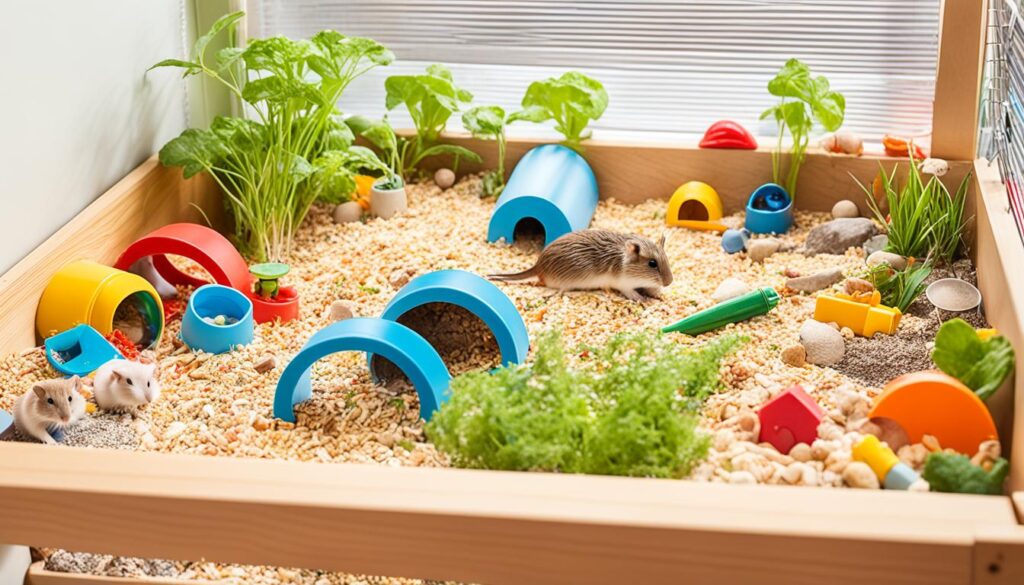
Avoid Wire Enclosures
Wire enclosures are not suitable for gerbils as they can cause harm to their delicate noses and teeth. However, if a wire enclosure is the only option available to you, make sure the spaces between the bars are small enough to prevent your gerbils from escaping or getting stuck.
Avoid Plastic Habitats
Plastic habitats should be avoided for gerbils, as they have the tendency to chew through them. Gerbils are avid chewers, and plastic materials can pose a choking hazard or result in toxic ingestion. It’s best to prioritize the safety of your gerbils by choosing a more durable and chew-proof habitat.
Creating a suitable habitat for your gerbils is essential for their overall well-being and happiness. By providing them with a spacious and secure environment, you can ensure that they have the freedom to exhibit their natural behaviors and thrive in their surroundings.
Gerbil Habitat Setup
Creating the perfect habitat for your gerbils is essential to ensure their health and happiness. Here are some tips for setting up their habitat:
- Temperature: Gerbils are sensitive to temperature changes, so it’s important to keep their habitat in a draft-free area away from extreme temperatures. The ideal temperature range for gerbils is between 65°F and 75°F (18°C to 24°C).
- Adoption Tips: When adopting gerbils, it’s best to choose same-sex pairs from the same litter. This ensures compatibility and reduces the chances of aggression. Remember to handle them gently and supervise children to prevent any accidents or spread of infectious diseases.
- Socialization: Gerbils are social animals and thrive in the company of their own kind. They should never be mixed with different species. It’s important to monitor their behavior and address any signs of aggression or dominance to ensure a harmonious living environment.
- Bedding: Provide your gerbils with proper bedding for their comfort and hygiene. Paper-based bedding is a popular choice as it is safe, dust-free, and absorbent. It provides a cozy and comfortable nesting material for gerbils to burrow in.
To give you a better idea of how to set up a gerbil habitat, take a look at the image below:
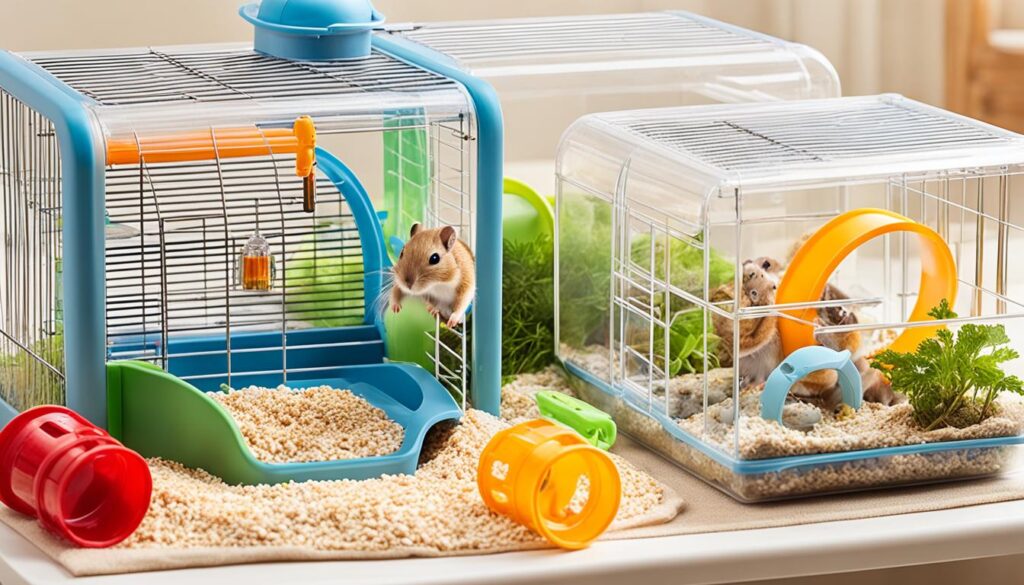
As you can see, the habitat includes a glass tank with a mesh lid for proper air circulation. It is filled with paper-based bedding for the gerbils to burrow and nest in. The habitat also contains various accessories such as an exercise wheel, hideaway place, and chew toys to keep the gerbils entertained and mentally stimulated.
Remember, a well-designed habitat with suitable temperature, appropriate socialization, and comfortable bedding is key to ensuring your gerbils lead a happy and healthy life.
Gerbil Diet & Nutrition
Proper nutrition is essential for the health and well-being of gerbils. A balanced diet ensures that gerbils receive the necessary nutrients to thrive. Here’s what you need to know about the diet and nutrition of gerbils:
1. Gerbil Lab Blocks
Gerbil lab blocks or pelleted food are specially formulated to meet the nutritional needs of gerbils. These blocks provide a complete and balanced diet and should form the basis of their daily meals. Look for high-quality lab blocks from reputable brands that are specifically designed for gerbil consumption.
2. Grains for Energy
Grains are an important component of a gerbil’s diet as they provide energy. Include a variety of grains such as oats, barley, and millet in their diet. These can be offered in limited quantities as treats or mixed in with their lab blocks. Ensure that the grains are plain and free from added sugars or seasonings.
3. Vegetables for Essential Nutrients
Vegetables are a great source of essential nutrients for gerbils. Offer a variety of vegetables like carrots, broccoli, and bell peppers. Chop them into small, bite-sized pieces to make it easier for gerbils to eat. Ensure that the vegetables are fresh and washed thoroughly before serving.
4. Fruits for Antioxidants
Fruits can be included in a gerbil’s diet as occasional treats. They provide natural sugars and antioxidants. Offer small portions of fruits like apples, bananas, and berries. Remove any seeds or pits before feeding them to gerbils. It’s important to note that fruits should be offered sparingly due to their high sugar content.
5. Fresh Water at All Times
Provide gerbils with fresh, clean water at all times. Use a shallow, chew-resistant bowl or a water bottle with a sipper tube. Check the water supply daily to ensure it is clean and replenish it as needed. Regularly clean and sanitize the water container to maintain hygiene.
6. Avoid Toxic Foods
Some foods can be toxic to gerbils and should be avoided altogether. Never feed gerbils chocolate, caffeine, alcohol, or any toxic substances. These can be harmful and potentially fatal to their health. Stick to safe and nutritious food options to keep gerbils healthy and happy.
By providing a balanced and varied diet, you can ensure that your gerbils receive the nutrition they need to thrive. Along with a proper diet, regular veterinary check-ups are also important to monitor their overall health.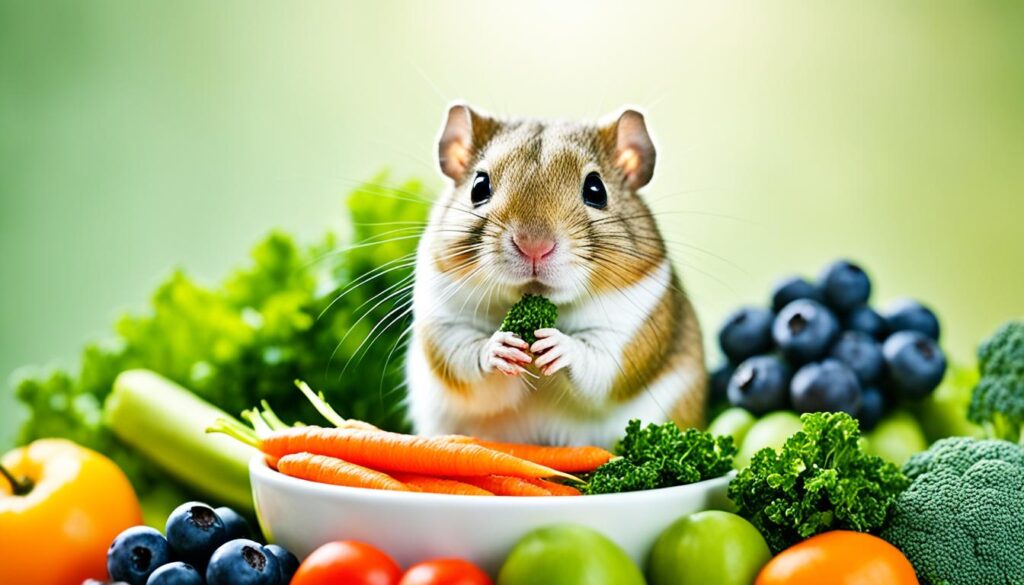
| Food Group | Examples | Feeding Guidelines |
|---|---|---|
| Gerbil Lab Blocks | Brand XYZ Gerbil Lab Blocks | Offer daily as the primary food source |
| Grains | Oats, barley, millet | Offer in limited quantities as treats or mixed with lab blocks |
| Vegetables | Carrots, broccoli, bell peppers | Offer a variety of vegetables daily, chopped into small pieces |
| Fruits | Apples, bananas, berries | Offer occasional small portions as treats |
| Water | Fresh, clean water | Provide at all times in a shallow bowl or water bottle |
“A well-balanced diet is the foundation of good health for gerbils.”
Gerbil Grooming & Care
Gerbils are naturally clean animals and groom themselves regularly, so they rarely require baths. However, proper grooming and care are still important to ensure their well-being. Here are some essential grooming tips for your gerbil:
Dust Bath
Giving your gerbil access to a dust or sand bath is crucial for maintaining their fur’s health. A dust bath helps them remove excess oil and dirt, preventing matting and skin issues. Fill a shallow container with chinchilla sand or chinchilla dust and place it in their habitat a few times a week. Watch as your gerbil happily rolls around and cleans itself.
Nail Care
Regular nail trimming is necessary to prevent overgrown nails, which can lead to discomfort and potential injury. Use small animal nail clippers or human nail clippers with a straight edge. Be cautious when trimming, making sure not to cut into the quick, which is the pink part of the nail containing blood vessels and nerves. If you’re unsure, seek guidance from a veterinarian or a professional pet groomer.
Spot-Cleaning
Spot-cleaning your gerbil’s enclosure daily helps maintain their habitat’s cleanliness and hygiene. Remove any soiled bedding, uneaten food, or waste to prevent unpleasant odors and bacterial growth. This simple task can be done swiftly and easily, ensuring a clean and comfortable living environment for your gerbil.
Full Cleanout
Every 1-2 weeks, conduct a full cleanout of your gerbil’s enclosure. Start by moving your gerbil to a temporary habitat, ensuring their safety during the cleaning process. Remove all bedding, toys, and accessories from the enclosure. Wash the enclosure and all items with mild soap and water, rinsing thoroughly to remove any residue. Allow everything to dry completely before adding fresh bedding and reintroducing your gerbil.
| Gerbil Grooming & Care | Frequency |
|---|---|
| Dust Bath | A few times a week |
| Nail Care | As needed |
| Spot-Cleaning | Daily |
| Full Cleanout | Every 1-2 weeks |
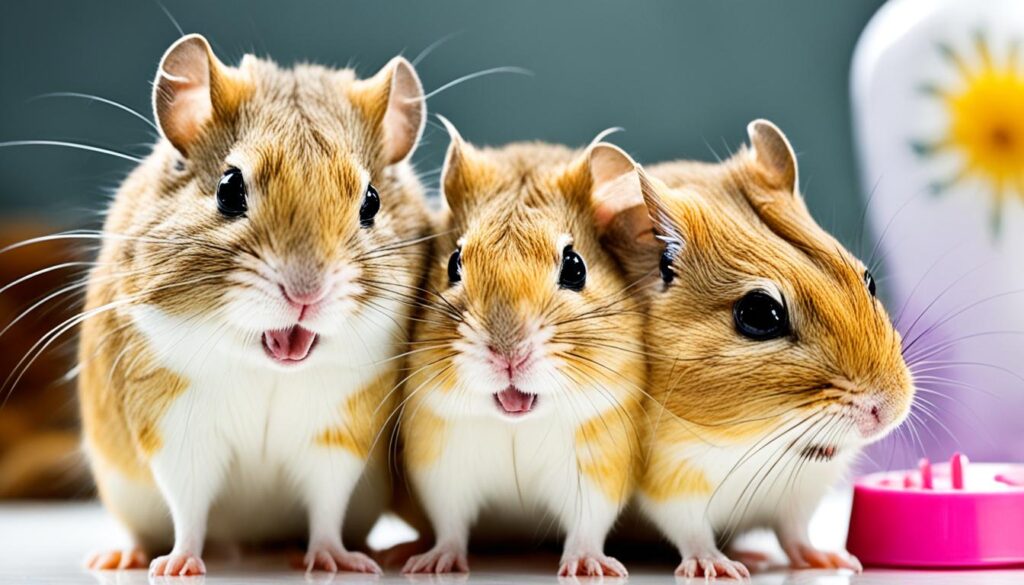
By following these grooming tips, you can ensure that your gerbil remains clean, healthy, and happy. Remember to provide a safe and stimulating environment for them, allowing them to thrive and live their best gerbil lives!
Gerbil Handling Tips
Building trust is crucial when it comes to gerbil handling. These small creatures can become comfortable with human interaction over time, but it requires patience and gentle approaches. One effective method is to use treats as a way to establish trust gradually.
“Treats should be used to establish trust gradually, starting from offering treats through the cage bars to eventually hand-feeding and allowing gerbils to sit on the hand.”
Start by offering treats through the cage bars, allowing the gerbil to approach and take them from your hand. This helps them associate positive experiences with your presence. As they become more comfortable, you can progress to hand-feeding, placing the treat in your hand and letting the gerbil climb onto your hand to retrieve it. This reinforces the bond and helps them build trust.
It’s important to remember that gerbils should never be squeezed or picked up by the tail. This can cause them pain and distress. Instead, use both hands to gently scoop them up, supporting their body and ensuring a secure grip.
When handling gerbils, avoid sudden movements or loud noises that can startle them. Instead, move slowly and calmly, speaking softly to reassure them. Lightly scratching the gerbil’s head is usually enjoyable for them and can help strengthen the bond.
It’s essential to note that gerbils may occasionally nibble or give gerbil bites. This is a natural defense mechanism or a result of feeling threatened. If a gerbil bites, avoid reacting with fear or anger, as it may cause them to continue biting. Instead, calmly place the gerbil back in its enclosure and give it some time to calm down before attempting to handle it again.
Remember, building trust and using gentle approaches are key to successful gerbil handling. With time and patience, you can develop a strong bond with your furry friends.
| Gerbil Handling Tips: | |
|---|---|
| 1. Offer treats through cage bars | Allow gerbil to approach and take treats from your hand |
| 2. Progress to hand-feeding | Let gerbil climb onto your hand to retrieve treats |
| 3. Never squeeze or pick up by the tail | Gently scoop gerbil with both hands, supporting their body |
| 4. Move slowly and calmly | Avoid sudden movements or loud noises |
| 5. Scratch lightly on the head | Enjoyable for gerbils and strengthens the bond |
| 6. If bitten, remain calm | Place gerbil back in enclosure and allow time to calm down |
Gerbil Enclosure Size
When it comes to providing a suitable habitat for your gerbils, the size of the enclosure plays a crucial role in their overall well-being. Gerbils are active animals that require enough space to satisfy their natural instincts and behaviors.
Space Requirements: A general guideline for gerbil enclosure size is between 10 and 20 gallons of space per gerbil. This ensures they have enough room to move, explore, and engage in various activities.
Horizontal and Burrowing Needs: Gerbils are known for their speedy movements and love for running and jumping. Therefore, it’s important to provide them with enough horizontal space to accommodate their active lifestyle. A spacious enclosure allows them to stretch their legs and exercise freely.
In addition to horizontal space, gerbils also have a natural instinct to burrow. They enjoy digging and creating tunnels, which provide them with a sense of security and privacy. It is essential to provide enough depth in the enclosure to allow for burrowing behaviors. This can be achieved by using a bedding material that allows them to dig and create tunnels.
Exploration: Gerbils are curious creatures that thrive on exploration. While a spacious enclosure is vital, it’s also beneficial to let your gerbils explore a larger area outside of the enclosure a few times a week. This can be done in a secure and supervised environment, such as a playpen or a designated gerbil-proofed room. Allowing them to explore beyond their enclosure provides mental stimulation and enriches their overall environment.
“A spacious and enriching enclosure is crucial for gerbil health and happiness, providing enough space for their horizontal movements, satisfying their burrowing instincts, and allowing for exploration outside of the enclosure.”
By ensuring the appropriate size for your gerbil’s enclosure and providing opportunities for exploration, you can create an environment that promotes their natural behaviors, keeping them happy and content.
| Enclosure Size Guidelines | Gerbil Population | Minimum Enclosure Size |
|---|---|---|
| Single Gerbil | 1 gerbil | 10-20 gallons |
| Gerbil Pair | 2 gerbils | 20-40 gallons |
| Gerbil Group | 3 or more gerbils | Add 10 gallons per additional gerbil |
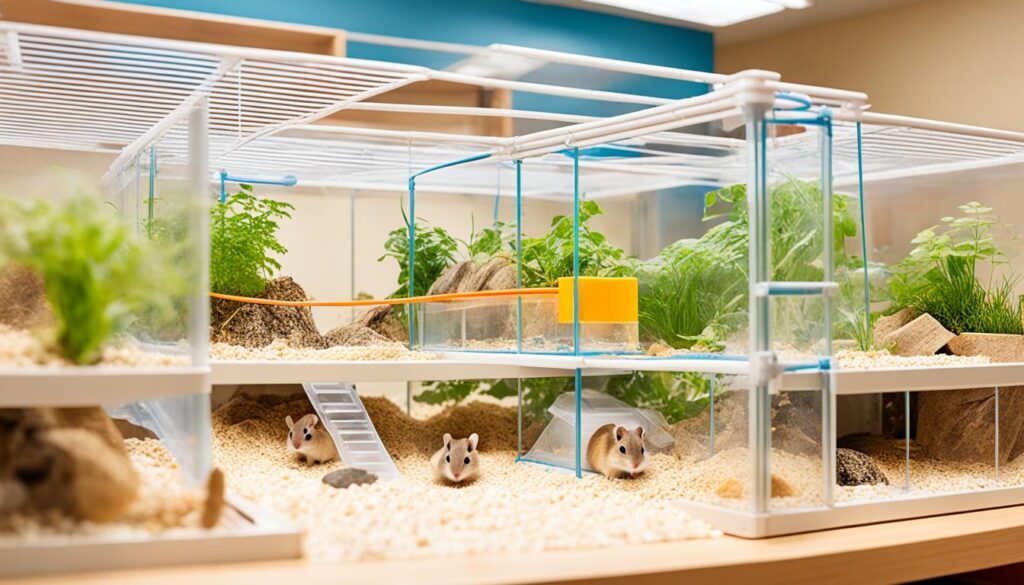
Gerbil Bedding Depth
Gerbils are natural burrowers and providing them with the right bedding depth is essential to fulfill their burrowing instincts. A minimum of 4-8 inches of bedding depth is recommended to allow gerbils to create tunnels and dig comfortably. This depth also helps in maintaining their body temperature and providing them with a sense of security.
When choosing bedding for your gerbils, opt for paper-based bedding or crumpled paper. These options are low-dust and digestible, ensuring the safety and health of your furry friends. Avoid using cedar or pine bedding as they can irritate gerbils’ skin and respiratory tracts.
Proper bedding depth not only enhances the natural behavior of gerbils but also promotes their overall well-being and comfort.
By providing the right bedding depth and material, you are creating an environment that mimics their natural habitat and allows them to express their natural instincts.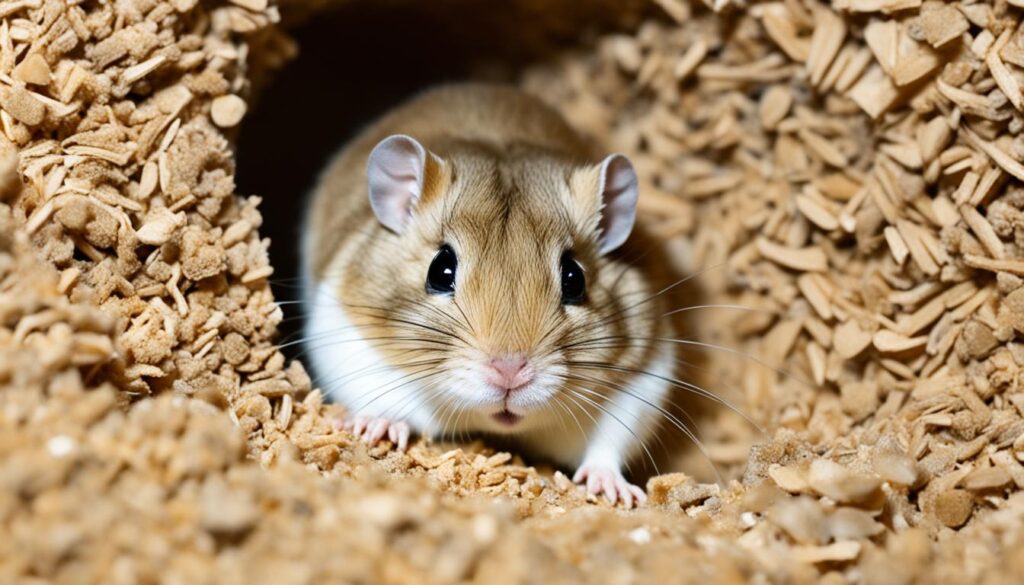
| Pros of Paper-Based Bedding | Cons of Cedar and Pine Bedding |
|---|---|
|
|
Gerbil Interaction and Entertainment
Gerbils are social and active creatures that thrive on interaction and stimulation. Providing them with toys and activities that cater to their natural instincts is essential for their overall well-being.
Here are some key elements to consider for gerbil interaction and entertainment:
Toys
Interactive toys are a great way to engage gerbils and keep them mentally and physically stimulated. Choose toys that encourage chewing and gnawing, as this helps wear down their constantly growing front teeth.
- Wooden blocks and chew sticks
- Tunnels and tubes made of cardboard or PVC
- Clay pots or ceramic balls for hiding treats
Exercise Wheel
An appropriately-sized exercise wheel is a must-have for gerbils to get their daily dose of physical activity. Gerbils have a natural instinct to run, and an exercise wheel allows them to fulfill this need. Make sure the wheel is solid and free from any sharp edges to prevent injuries.
Sand Bath
Gerbils love to keep themselves clean by taking sand baths. A sand bath is not only entertaining for them but also helps remove excess oils from their fur. Use chinchilla sand or special sand bath dust that is safe for gerbils. Place it in a separate dish or container within their habitat.
Climbing and Exploring
Gerbils are excellent climbers and enjoy exploring their environment. Offer them branches, wooden ladders, and rocks to climb on. This not only provides them with mental stimulation but also encourages their natural behaviors.
Gerbi Gerbils are energetic little creatures that thrive on social interaction and mental stimulation. Providing them with a variety of toys and activities will keep them entertained and happy.
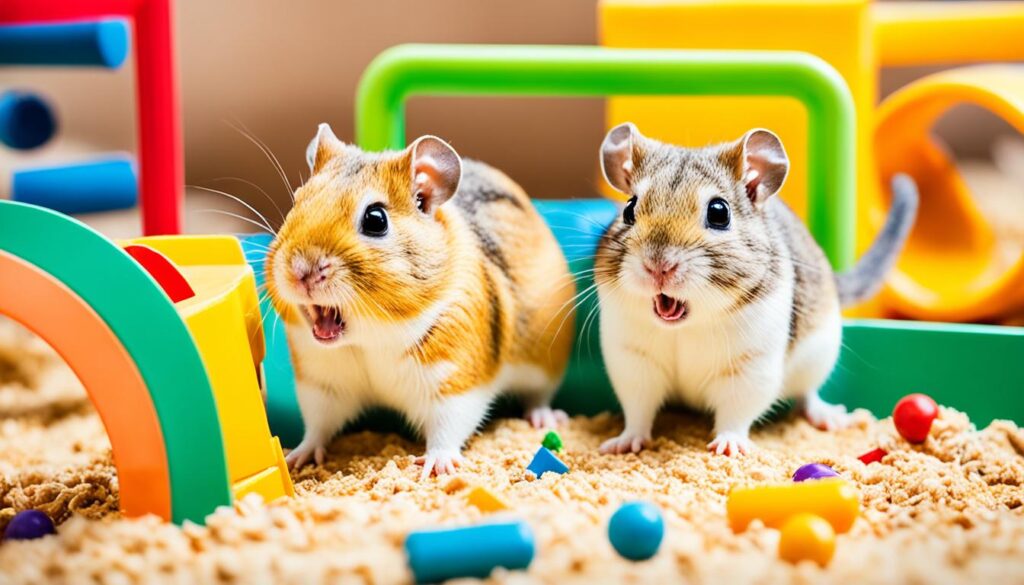
By incorporating these interaction and entertainment elements into your gerbil’s habitat, you are creating a stimulating environment that mimics their natural instincts. Remember to observe your gerbils and tailor their toys and activities to their preferences.
Gerbil Enclosure Cleaning
Proper cleaning and maintenance of your gerbil’s enclosure is essential for their health and well-being. Regular spot-cleaning and occasional full cleanouts help maintain a clean and hygienic habitat for your furry friends. Here’s a step-by-step guide on how to effectively clean your gerbil’s enclosure:
Spot-Cleaning
- Remove any soiled bedding, uneaten food, or waste on a daily basis. This helps prevent odors and keeps the enclosure tidy.
- Use a small scoop or shovel to carefully remove the soiled material, being mindful not to disturb any nest or tunnel structures.
- Replace the removed bedding with fresh, clean bedding to maintain comfort and hygiene.
Full Cleanout
While spot-cleaning is sufficient for regular maintenance, a full cleanout should be done every 1-2 weeks. This allows for a thorough cleaning of the entire enclosure and ensures a healthy living environment for your gerbils.
- Prepare a temporary enclosure for your gerbils. This can be a spare cage or a secure container with adequate space and supplies.
- Remove all accessories, toys, and bedding from the main enclosure.
- Wash the enclosure and accessories with a mild soap or pet-safe cleaner. Rinse them thoroughly to remove any residue.
- Disinfect the enclosure and accessories by using a pet-safe disinfectant or a solution of one part bleach to ten parts water. Ensure proper ventilation and rinse off the disinfectant thoroughly.
- Allow the enclosure and accessories to dry completely to prevent moisture buildup, which can lead to mold or bacterial growth.
- Place fresh, clean bedding and accessories back into the enclosure.
- Return your gerbils to their clean and sanitized habitat.
Regular cleaning and disinfection of your gerbil’s enclosure help prevent the buildup of harmful bacteria and parasites, ensuring a healthy and safe habitat. Remember to always use pet-safe cleaning products and provide fresh bedding for your gerbils’ comfort.
| Enclosure Cleaning Checklist | Frequency |
|---|---|
| Spot-Cleaning | Daily |
| Full Cleanout | Every 1-2 weeks |
Gerbil Housing and Handling Tips
When it comes to housing your gerbils, it’s important to provide them with a cage or tank that meets their needs. Ensure that the enclosure is spacious enough for them to move around comfortably and engage in their natural behaviors. Adequate ventilation is crucial for their well-being, so choose a housing option that promotes proper airflow.
Enclosure Type: A glass tank with a secure mesh lid is often the best choice for gerbils. It not only provides the required ventilation but also prevents them from escaping. Wire enclosures, on the other hand, should be avoided as they can cause injuries to gerbils’ teeth and noses. If you must use a wire enclosure, ensure that the bar spacing is narrow and suitable for their size to prevent any undesirable accidents. Plastic habitats should also be avoided as gerbils have a tendency to chew through them.
Gerbil Behavior: It’s essential to observe your gerbils regularly for any signs of declanning, which is the separation of gerbils within a group. Declanning can lead to aggression and fights among gerbils, so immediate action should be taken if any signs are noticed. Provide ample hiding places and multiple feeding stations within their enclosure to reduce social stress and minimize the risk of declanning.
Handling Instructions: Handling gerbils requires care and consistency. Start by building trust gradually, offering treats through the cage bars to establish positive associations. Over time, you can move on to hand-feeding and allowing gerbils to sit on your hand. Avoid picking them up by their tails, as this can cause them pain and injury. Instead, scoop them gently from below, supporting their body. Remember, regular and gentle handling is crucial for fostering trust and minimizing stress for your gerbils.
| Housing Tips | Handling Tips |
|---|---|
| Choose a spacious enclosure with proper ventilation | Build trust gradually through treats and positive associations |
| Avoid wire enclosures and plastic habitats | Avoid picking gerbils up by their tails |
| Observe for signs of declanning | Handle gerbils gently and consistently |
Gerbil Attitude and Behavior
Gerbils are fascinating creatures with unique attitudes and behaviors. Understanding their social nature and sleep patterns is key to providing them with a happy and healthy environment.
Social Nature
Gerbils are highly social animals and thrive in pairs or small groups. They enjoy the company of their own kind and rely on social interactions for their well-being. Keeping gerbils alone can lead to loneliness and boredom, which can negatively impact their behavior and overall health.
When introducing new gerbils, it’s important to follow proper techniques to prevent aggressive behavior. Gradual introductions in a neutral territory and monitoring their interactions closely can help establish harmonious relationships.
Activity and Sleep Patterns
Gerbils are diurnal animals, meaning they are active during the day and sleep in short naps. Their natural behavior involves exploring their surroundings, digging tunnels, and running on their exercise wheel. Providing ample opportunities for physical and mental stimulation is essential to fulfill their natural instincts.
It’s important to create a quiet and undisturbed sleeping area for gerbils in their habitat. Providing a cozy nest box or hiding spot can help them feel secure and promote restful sleep.
Handling with Care
When handling gerbils, it’s important to approach them with patience and care. Sudden movements or rough handling can cause stress or fear-induced aggression. Building trust through gradual interactions and positive reinforcement can help foster a bond between you and your gerbil.
Remember, gerbils have different personalities and temperaments. Some may be more outgoing and receptive to handling, while others may be more cautious or timid. Respect their individual preferences and never force them into interactions they’re not comfortable with.
By understanding and respecting gerbil behavior, you can create a harmonious and enriching environment for your furry friends.
Gerbil Attitude and Behavior Overview
| Aspect | Description |
|---|---|
| Social nature | Gerbils are highly social and thrive in pairs or small groups. They enjoy social interactions and should not be kept alone. |
| Activity patterns | Gerbils are diurnal animals and are active during the day. They sleep in short naps and require mental and physical stimulation. |
| Sleeping habits | Gerbils require a quiet and undisturbed sleeping area in their habitat. Providing a cozy nest box promotes restful sleep. |
| Handling tips | Gerbils should be handled with care and gentleness. Building trust through gradual interactions can help establish a positive bond. |
Gerbil Habitat Requirements
When it comes to providing the ideal habitat for your gerbils, there are a few key factors to consider to ensure their well-being. The size and material of the enclosure, ventilation, and safety measures are all important aspects that contribute to a comfortable and secure gerbil habitat.
Size and Space
Gerbils are active animals that require ample space to engage in their natural behaviors such as burrowing and running. The size of the enclosure should be suitable to accommodate these activities. A general guideline is to provide between 10 and 20 gallons of space per gerbil. This allows them plenty of room to explore, play, and express their natural instincts.
Here’s a suggested enclosure size:
| Enclosure Type | Dimensions |
|---|---|
| Glass Tank | Minimum 18” L x 30” W x 12” H |
| Wire Cage | Narrow bar spacing to prevent escape or injury |
| Plastic Habitat | Not recommended due to lack of durability and proper ventilation |
Ventilation and Material
Proper ventilation is crucial for maintaining a healthy habitat for your gerbils. Glass tanks with secure mesh lids are recommended as they provide adequate airflow and prevent escape. Wire cages can also be used, but it’s important to choose one with narrow bar spacing to avoid injury and ensure the gerbils cannot squeeze through. Avoid plastic habitats as gerbils have a natural chewing behavior and may damage or escape from them.
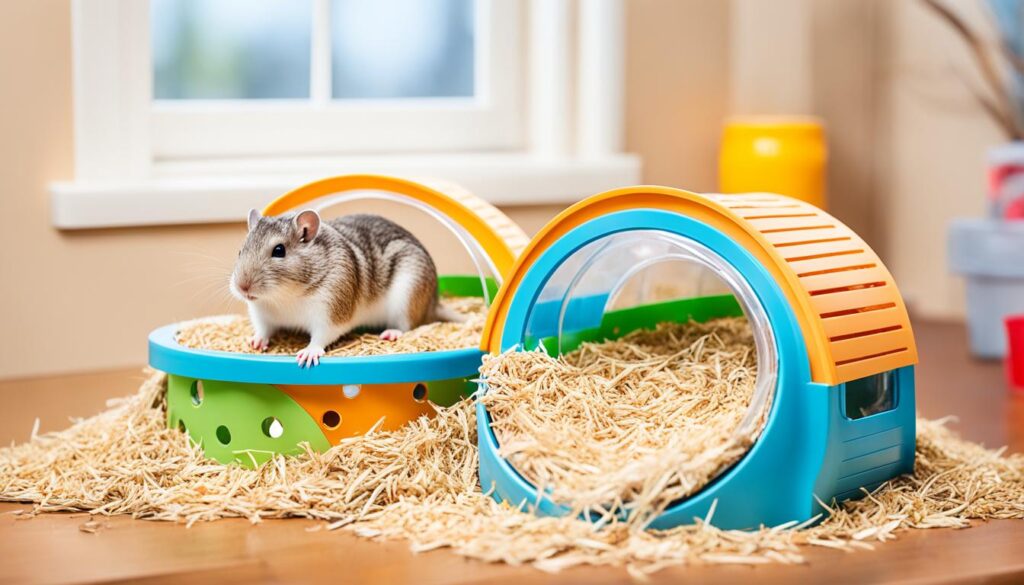
Safety Measures
When setting up the gerbil habitat, safety should always be a top priority. Ensure that there are no sharp edges or hazardous materials that could harm the gerbils. Remove any small items that they could swallow and cause choking. Regularly inspect the enclosure for any signs of wear and tear, and promptly repair or replace damaged parts to maintain a safe environment for your pets.
In summary, providing a suitable gerbil habitat involves considering the size, material, ventilation, and safety measures. By meeting these requirements, you can create a comfortable and secure living space for your gerbils to thrive.
Gerbil Accessories and Bedding
When it comes to providing a comfortable and enriching habitat for gerbils, choosing the right accessories and bedding is essential. These elements not only enhance their living space but also promote their physical and mental well-being. Let’s explore the key components for creating a gerbil-friendly environment.
Nest Box: A Cozy Retreat
A nest box made of wood or ceramic is an ideal addition to a gerbil’s habitat. This cozy hideaway provides them with a secure and private space for resting and sleeping. Gerbils love to burrow, so make sure the nest box has enough soft bedding material to create a snug and comfortable nest.
Climbing Materials: Adding Vertical Excitement
Gerbils are natural climbers, and incorporating climbing materials into their habitat can add an extra dimension of excitement. Include branches, wood platforms, rocks, and ramps to create vertical elements for them to explore and play on. These climbing materials not only provide physical exercise but also stimulate their natural instincts.
Chewing Toys: Healthy Dental Care
Chewing is an important activity for gerbils as it helps keep their teeth healthy and prevents overgrowth. Provide them with a variety of safe chew toys made of natural materials like wood or cardboard. These toys not only satisfy their instinct to chew but also provide mental stimulation and help prevent boredom.
Bedding Options: Comfort and Hygiene
Choosing the right bedding is crucial for keeping your gerbil’s habitat clean, comfortable, and hygienic. Paper-based bedding and unbleached paper towels are excellent options as they are absorbent, low-dust, and safe for gerbils. Avoid using cedar and pine bedding as they can cause respiratory issues.
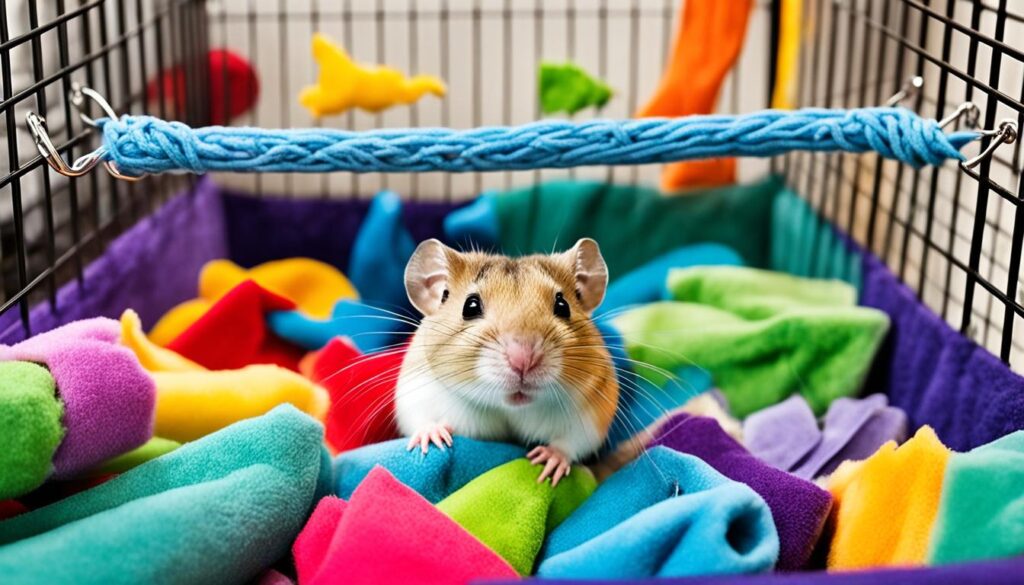
| Accessory | Description |
|---|---|
| Nest Box | A cozy retreat made of wood or ceramic for gerbils to rest and sleep. |
| Climbing Materials | Vertical elements like branches, wood platforms, rocks, and ramps for climbing and exploration. |
| Chewing Toys | Safe chew toys made of natural materials to promote dental health and mental stimulation. |
| Bedding Options | Paper-based bedding and unbleached paper towels for comfort, absorption, and hygiene. |
By incorporating these accessories and bedding options into your gerbil’s habitat, you can create a stimulating and comfortable environment that promotes their natural behaviors and overall well-being.
Conclusion
Owning a gerbil can be a truly rewarding experience. These small and social creatures can bring joy and companionship to our lives. However, it’s important to provide them with the proper care and attention they need. By following the guidelines for habitat, diet, grooming, handling, and maintenance, we can ensure the well-being and happiness of our gerbils.
When it comes to their habitat, make sure to provide a spacious enclosure that allows for their natural behaviors like running, burrowing, and exploring. A mix of gerbil lab blocks, grains, vegetables, and fruits will ensure a balanced diet. Regular grooming, including dust baths and nail care, will keep our gerbils clean and healthy.
Building trust with our gerbils is crucial. Slowly and patiently gaining their trust through treats and gentle handling will create a strong bond between us. Remember to always handle them with care, never squeezing or picking them up by the tail.
In conclusion, with the right care and attention, owning a gerbil can be a wonderful experience. By providing a safe and stimulating environment, following proper feeding and handling techniques, and ensuring their overall well-being, we can enjoy the company of these delightful pets for many years to come.FAQ
What are some important tips for gerbil care?
Where are gerbils native to, and what is the most common species kept as pets?
How long do gerbils live, and how big do they get?
What should be included in a gerbil’s habitat?
What type of enclosure is recommended for gerbils?
What should be considered when adopting gerbils?
What should gerbils be fed, and what foods should be avoided?
How should gerbils be groomed and maintained?
What is the recommended enclosure size for gerbils?
How deep should the bedding be in a gerbil’s habitat?
What toys and accessories should be provided for gerbils?
How often should a gerbil’s enclosure be cleaned?
What are some tips for housing and handling gerbils?
What is the attitude and behavior of gerbils?
What are the requirements for a gerbil’s habitat?
What accessories and bedding should be provided for gerbils?
What are the final tips for gerbil care?
Dana is our Lead Content Writer, bringing a wealth of knowledge and expertise to our team. With a background deeply rooted in animal studies and a profound love for all creatures, Dana is dedicated to crafting engaging and informative content that resonates with our audience. With Dana at the helm, you can trust that our content is accurate and engaging, catering to the diverse interests of animal enthusiasts everywhere.
Gerbil
Gerbils Eat Apples: A How-To Guide for Safe Feeding
Open the door to safe apple feeding for gerbils – learn how to provide balanced nutrition and avoid pitfalls.
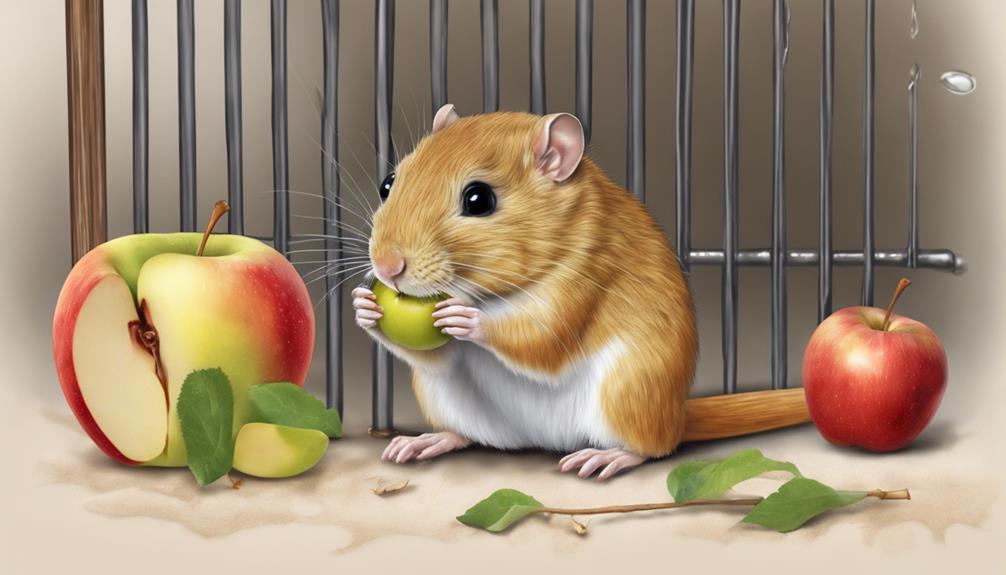
When we give gerbils apples, it is crucial to recognize the advantages and potential dangers involved. Apples are packed with fiber, potassium, and vitamin A, which help with digestion and overall health. However, it is essential to be cautious of apple seeds as they can be toxic and lead to stomach complications. Stick to safe varieties such as red or green apples and keep in mind that moderation is crucial due to their high sugar content. Limit the amount of apples to a 25g slice for your gerbil to ensure a well-rounded diet and healthy weight.
More insights await to help you keep your gerbil happy and healthy.
Key Takeaways
- Choose red or green apples for gerbils' safety and preference.
- Limit apple slices to 25g to prevent health risks.
- Avoid apple seeds and acidic varieties to protect gerbils.
- Moderation is crucial due to high sugar and water content.
- Monitor apple intake to maintain a balanced diet and weight.
Benefits of Apples for Gerbils
When it comes to enhancing the diet of gerbils, incorporating apples can provide vital nutrients for their health and digestion. Apples are a fantastic addition to a gerbil's diet due to their high fiber content, which aids in digestion and helps prevent constipation.
Additionally, these fruits are rich in potassium and vitamin A, supporting overall well-being in gerbils and contributing to a balanced diet. The minimal calories, protein, and fat in apples make them a healthy treat option for our furry friends.
Both the skin and flesh of apples offer unique nutritional benefits, so it's crucial to provide them with a variety of textures. However, it's important to remember that apples should be given in moderation to avoid potential digestive issues caused by their high sugar content.
Nutritional Value of Apples
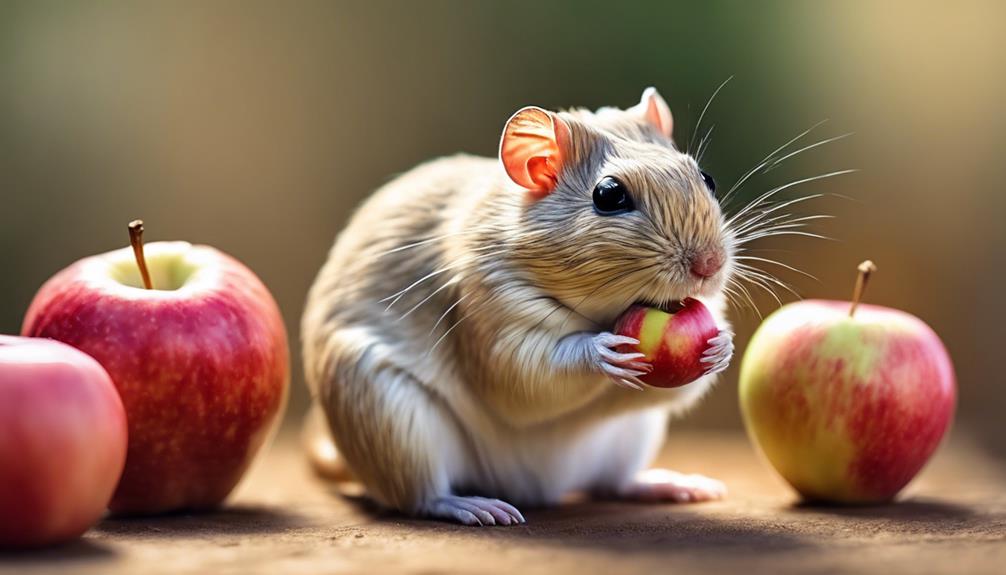
Incorporating apples into a gerbil's diet provides valuable nutrients essential for their overall well-being and health. Apples are rich in fiber, potassium, and vitamin A, offering essential nutrients for gerbils.
They provide minimal calories, protein, and fat, making them a healthy addition to a gerbil's diet. The skin and flesh of apples each contribute different nutritional benefits to gerbils.
Including apples in moderation can aid digestion and promote gut health in gerbils. Apples support overall health in gerbils by providing essential vitamins and minerals. These fruits are a great source of fiber, aiding in digestion and keeping the gerbil's digestive system healthy.
The vitamins and minerals in apples contribute to the gerbil's overall well-being and help support their immune system. Moderation is key when feeding apples to gerbils to maintain a balanced diet and prevent any potential health issues.
Risks of Feeding Apples
Feeding gerbils excessive amounts of apples can lead to digestive issues due to their high water content, making moderation essential to prevent potential health risks. While apples can be a tasty treat for gerbils, it's important to be mindful of the risks associated with overfeeding. Here are some key points to keep in mind when offering apples to your furry friends:
| Risk Factor | Description |
|---|---|
| Apple Seeds | Toxic to gerbils and should be avoided at all costs. |
| Sugar Content | High sugar levels can cause stomach pain and health problems. |
| Acidic Nature | The acidity of apples may harm the delicate mouth and stomach lining. |
| Moderation | Feeding apples in moderation is crucial to prevent potential risks. |
| Health Risks | Overindulging in apples can lead to digestive issues and toxicity. |
Safe Apple Varieties for Gerbils

To guarantee the prime health of gerbils, it's advisable to provide them standard apple varieties such as red or green apples. These types are safe for small gerbils to eat and are easier on their digestive systems compared to cooking apples. Here are some key points to bear in mind when choosing apple varieties for your gerbil:
- Stick to Standard Varieties: Opt for red or green apples as they're safe and enjoyable for gerbils.
- Avoid Cooking Apples: Cooking apples are more acidic and may not be as well-tolerated by gerbils.
- Prevent Digestive Issues: Choosing standard apple types can help avoid stomach problems in gerbils.
- Consider Taste Preferences: Some gerbils may not like the sour taste of cooking apples due to their higher acidity levels.
Moderation in Apple Feeding
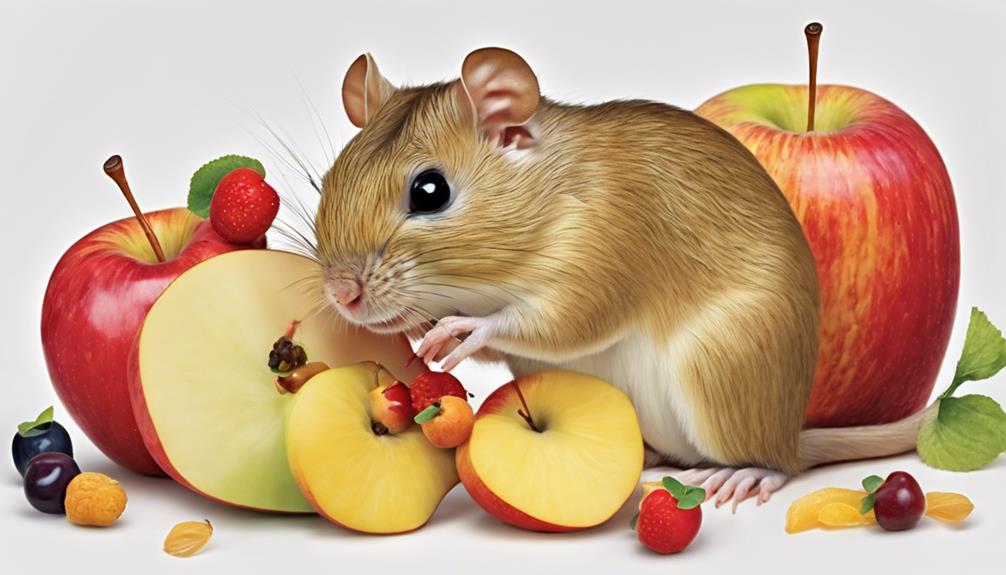
When considering the diet of gerbils, it is important to be mindful of the amount of apples they consume to maintain their health and well-being. Controlled consumption of apples is vital to guarantee a balanced diet for gerbils. Moderation in apple feeding plays a critical role in preventing health risks associated with high sugar content and portion control issues. Responsible pet ownership involves monitoring and regulating the apple intake of gerbils to promote ideal health. Limiting apple intake to a 25g slice can help prevent digestive problems and maintain a healthy weight for your furry companion.
| Key Points | Details | Importance |
|---|---|---|
| Apple intake | Limit apples to a 25g slice for gerbils | Prevents issues |
| Controlled consumption | Guarantees a balanced diet for gerbils | Promotes well-being |
| Health risks | High sugar content can lead to problems | Maintain health |
| Pet ownership | Monitor and regulate apple intake for gerbils | Responsible care |
| Portion control | Moderation helps in preventing obesity issues | Weight management |
Frequently Asked Questions
Can I Feed My Gerbil Apples?
Yes, we can feed gerbils apples as an occasional treat. Apples offer fiber, potassium, and vitamin A. Limit intake to a 25g slice to avoid digestive issues. They provide minimal calories, protein, and fat, supporting overall health in gerbils.
How Much Should Gerbils Be Fed?
When feeding gerbils, we give about 25g of apple as a treat, ensuring a balanced diet with fruits, veggies, and plant matter. Moderation prevents digestive issues, keeping these adorable creatures healthy and happy.
How Do You Put a Gerbil on a Diet?
To put a gerbil on a diet, we gradually reduce treats and high-calorie foods, increase hay and fresh veggies, monitor weight, consult a vet for personalized advice, implement a feeding schedule, and avoid overfeeding.
Do Gerbils Need a Food Bowl?
Oh, the irony of it all! Gerbils, dear friends, do not require a food bowl. Scatter feeding taps into their natural instincts, promotes exploration, and keeps those little munchkins engaged and happy.
Is it Safe for Gerbils to Eat Apples as Part of Their Care?
Yes, it is safe for gerbils to eat apples as part of their gerbil care tips insights. Apples are a great source of vitamins and fiber for gerbils, but they should be given in moderation to prevent digestive issues. Remove seeds and core before feeding to your pet.
Conclusion
To sum up, feeding gerbils apples can be a tasty and nutritious treat when done in moderation. Remember to choose safe apple varieties and remove any seeds or cores to prevent choking hazards.
By incorporating apples into your gerbil's diet, you can provide them with essential vitamins and minerals that contribute to their overall health and well-being.
So go ahead, give your furry friends a slice of apple goodness!
Paul’s love for animals knows no bounds. As a dedicated writer and animal lover, Paul brings a unique perspective to our team. His firsthand experiences with various animals enrich our content and provide valuable insights into their behavior and needs. Whether he’s sharing tips for pet care or shedding light on pressing conservation issues, Paul’s passion for animals shines through in everything he does.
Gerbil
Gerbils Eat Carrots: a How-To Guide for Safe Feeding
Feeding gerbils carrots can be a nutritious treat, but there's a crucial factor starting with the letter 'F' that you don't want to miss!
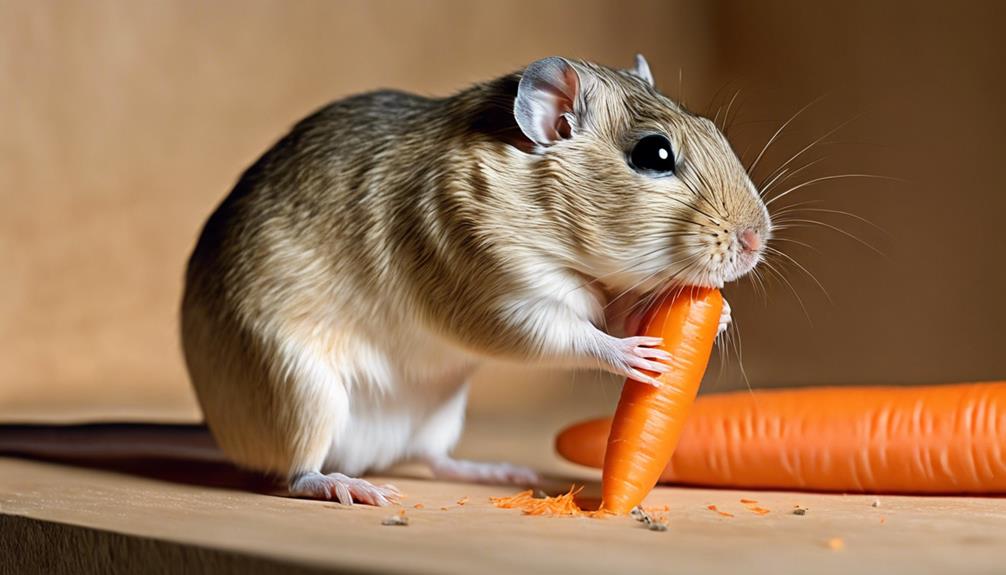
When it comes to feeding gerbils carrots, we have all the necessary supplies. Fresh, raw carrots are a safe option for gerbils in moderation, as they provide important nutrients like vitamin A. It’s important to remember that carrots should not be the only food in their diet. Begin with small servings, adjust as necessary, and ensure that the carrots are clean. Including carrot tops can also boost the nutritional value of their diet.
Moderation is key, and maintaining a varied diet keeps them healthy. Try it out and discover how gerbils enjoy this nutritious treat!
Key Takeaways
- Start with small portions to monitor gerbils' response to carrots.
- Adjust portion size based on gerbils' interaction with carrots.
- Introduce carrots gradually to prevent digestive issues.
- Ensure clean, pesticide-free carrots for gerbils.
- Remove uneaten carrot pieces promptly to maintain cleanliness.
Gerbils and Carrots: Feeding Safety Tips
When offering fresh, raw carrots to gerbils, it's important to prioritize their safety and well-being by following specific feeding guidelines. Gerbils can eat carrots as part of a balanced diet, providing essential nutrients like vitamin A. However, importance is key to prevent any potential dietary imbalances. Including carrot tops can enrich their diet with additional nutrients, contributing to a healthy gerbil diet.
Gerbils' teeth continuously grow, making it essential to offer them foods like fresh fruits and vegetables, such as carrots, for chewing and wearing down their teeth naturally. Ensuring their diet includes a variety of foods like carrots can help maintain their dental health. It's essential to remember that while carrots are a suitable snack, they shouldn't be the sole component of a gerbil's diet. Providing fresh water alongside carrot snacks is crucial to keep gerbils hydrated and healthy. By following these feeding safety tips, gerbil owners can promote the overall well-being of their furry companions.
Can Gerbils Safely Eat Carrots?

Gerbils can safely enjoy raw carrots as a nutritious snack in their balanced diet, providing essential vitamins and aiding in dental health. Including small amounts of carrots in their diet can help keep their teeth healthy and provide specific nutritional benefits.
When offering carrots to gerbils, make sure they're fresh and washed thoroughly to remove any pesticides or dirt. Remember that while carrots are safe for your gerbils, they should be just one component of a varied diet. Offering a mix of seeds, fruits, vegetables, and water will guarantee your gerbils receive all the necessary nutrients for top-notch health.
While gerbils enjoy carrots, it's crucial to avoid certain foods like sugary treats and high-fat snacks that can be harmful to their well-being. Remember, moderation is key when it comes to treating your furry friends with carrots.
Feeding Gerbils Carrots: Step-By-Step Guide
To properly introduce fresh carrots into a gerbil's diet, it is essential to follow a gradual and monitored approach. When offering carrot slices to gerbils, start with small portions to gauge their response. Monitor how they interact with the carrot and adjust the portion size accordingly. It's essential to introduce carrots gradually to prevent digestive issues and watch for any adverse reactions. Always make sure the carrots are clean and pesticide-free before feeding them to your gerbils. If any carrot pieces are left uneaten, promptly remove them from the enclosure to maintain cleanliness and prevent spoilage.
| Key Points | |
|---|---|
| Offer small portions | Monitor response |
| Adjust portion size | Introduce gradually |
| Remove uneaten pieces | Check for adverse reactions |
Gerbil Diet: Including Carrots Safely
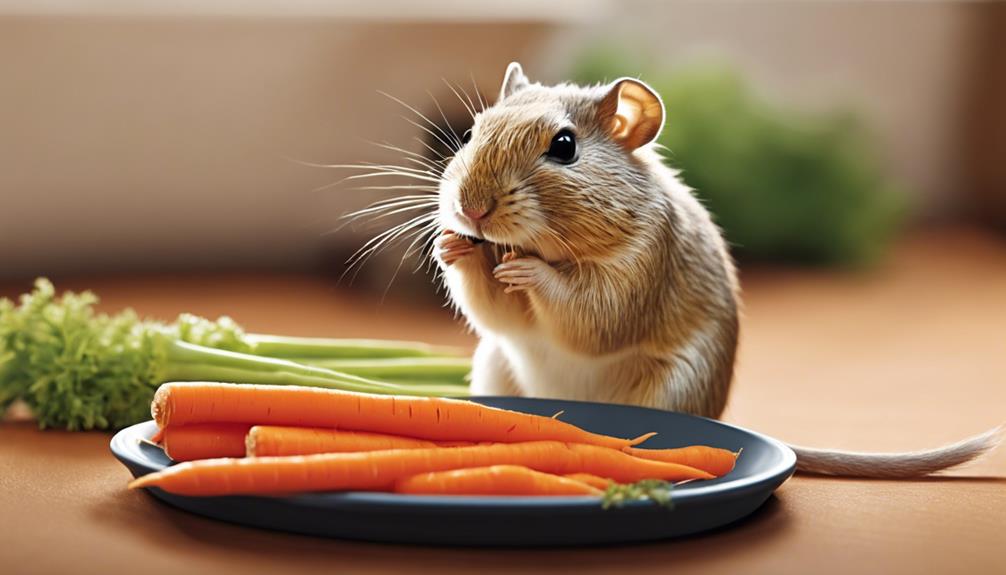
Including carrots safely in a gerbil's diet enhances their nutrition and provides essential vitamins and minerals for optimum health. Carrots can be a fantastic addition to a gerbil's diet for a variety of reasons:
- Vitamin K: Carrots are rich in vitamin K, which plays a vital role in blood clotting and bone health for gerbils.
- B Vitamins: Gerbils can benefit from the B vitamins found in carrots, supporting their metabolism and overall well-being.
- Carrot Tops: Offering carrot tops along with the carrots can provide additional nutrients and variety to the gerbil's diet, promoting a balanced nutritional intake.
Safe Carrot Consumption for Gerbils
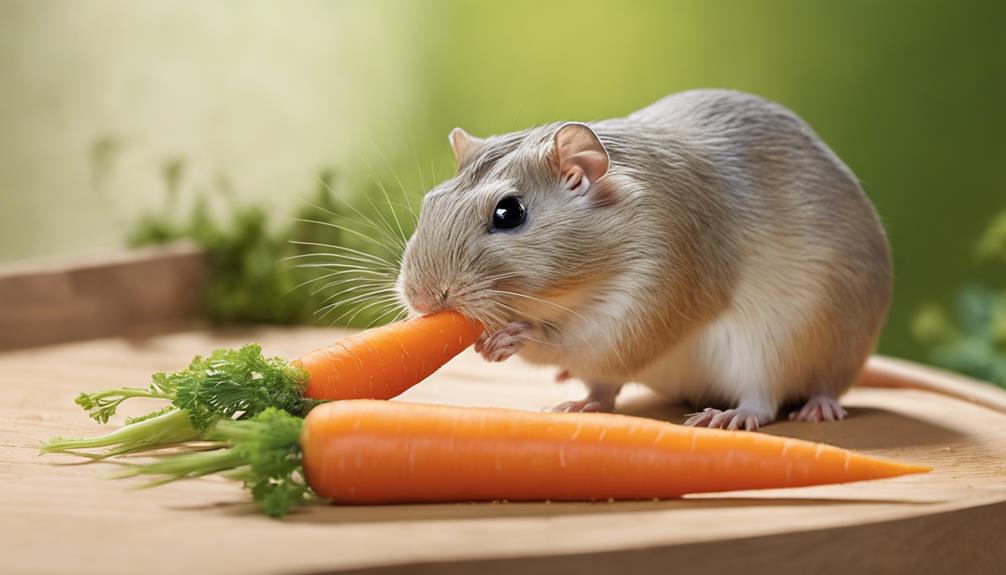
Ensuring safe consumption of carrots for gerbils involves monitoring their intake alongside a balanced diet. Carrots, with their vital low-calorie and hydrating properties, can be a delightful addition to a gerbil's diet that includes essential vitamins and minerals like Vitamin A, K, magnesium, and manganese. While gerbils can enjoy the crunchy flesh and nutrient-rich tops of carrots, it's important to offer them infrequently and in small portions to prevent health issues. Including a variety of safe vegetables like carrots aids in overall well-being by providing necessary nutrients.
When feeding carrots to gerbils, it's important to take into account the potential risks. While carrots are generally safe, feeding them in excess or alongside citrus fruits or sunflower seeds can cause digestive problems. Baby gerbils, in particular, require extra care when introducing new foods. Hence, whether gerbils are adults or babies, it's essential to make sure that carrots are given as part of a balanced diet to maintain their health and well-being.
Frequently Asked Questions
How Do You Feed Gerbils Carrots?
When feeding gerbils carrots, offer small, fresh slices gradually. Watch for adverse reactions and remove uneaten pieces promptly. Monitor their health post-introduction. Maintaining cleanliness is essential. All these steps guarantee your gerbil enjoys a safe and nutritious snack.
What Foods Are Toxic to Gerbils?
Some foods toxic to gerbils include citrus fruits, grapes, onions, garlic, and chocolate. These can lead to health issues or be fatal. Stick to a diet of gerbil-safe foods to keep your furry friends healthy and happy.
Can Gerbils Have Celery and Carrots?
Yes, gerbils can enjoy celery and carrots as part of a balanced diet. These crunchy treats can help wear down their teeth and provide essential nutrients. Moderation is key to prevent digestive issues and add variety to their diet.
How Much Do Gerbils Eat a Day?
We gerbil enthusiasts know that these tiny creatures have big appetites, typically consuming 10-15 grams of food per day. It's important to provide a varied diet to guarantee their health. Monitoring and adjusting their intake is key.
Are Apples Safe for Gerbils to Eat Like Carrots?
Yes, you can safely feed gerbils apples. However, like carrots, fruits should be given in moderation due to their high sugar content. Too much fruit can lead to health issues for gerbils. It’s best to offer a balanced diet of pellets, hay, and fresh vegetables alongside occasional fruit treats.
Conclusion
To sum up, feeding carrots to gerbils can be a safe and nutritious treat when done correctly. By following the step-by-step guide and safety tips provided, gerbil owners can guarantee that their furry friends enjoy this tasty snack without any negative consequences.
Remember, a balanced diet is key to keeping your gerbil healthy and happy, so be sure to include carrots in moderation alongside other suitable foods.
Stay tuned for more helpful tips on caring for your gerbil!
As our Editor-in-Chief, James plays a pivotal role in ensuring the quality and integrity of our content. With a keen eye for detail and a passion for storytelling, James oversees the editorial process here at A Place for Animals. With years of experience in content editing, James ensures that every piece of content meets our high standards of accuracy and clarity. Under James’ guidance, you can rest assured that the content you read is informative and impeccably crafted.
Gerbil
Can Gerbils Eat Strawberries? Find Out Here!
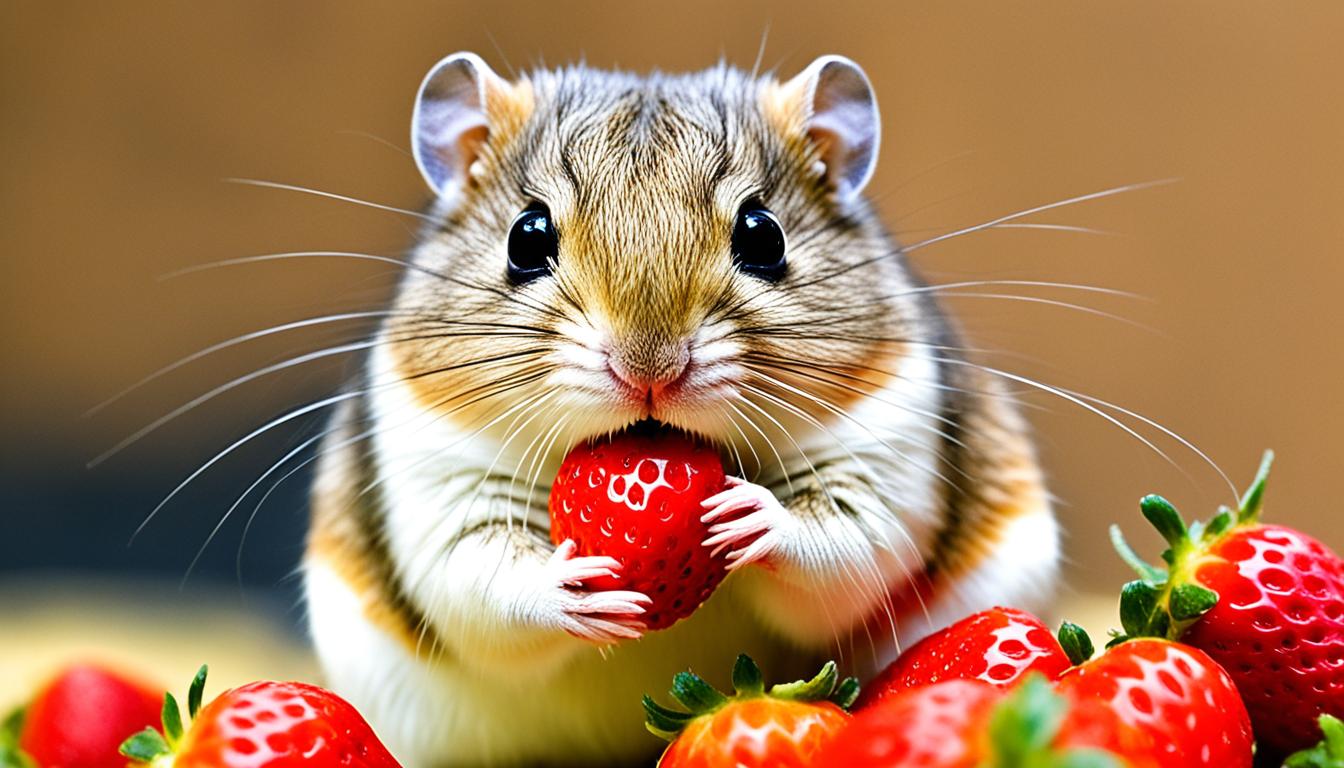
Did you know that gerbils, those cute little rodents, can actually savor the occasional strawberry? That’s correct! These tiny furry animals, recognized for their inquisitive nature, are not just omnivores but can also relish the sweet and juicy flavor of strawberries. However, before you begin giving your gerbil a bowl of strawberries, there are some essential points you should be aware of. Let’s explore the realm of gerbils and strawberries to comprehend the risks, advantages, and proper feeding techniques for offering these delightful treats to your furry companions.
Key Takeaways:
- Gerbils can eat strawberries as a treat, but it’s important to feed them in moderation.
- Strawberries are high in water and natural sugars, which can lead to gastrointestinal issues if fed in large quantities.
- Strawberries contain vitamin C and can provide variety to a gerbil’s diet.
- Offer strawberries in small amounts and monitor your gerbil’s reaction and behavior.
- Remember to prioritize a balanced and healthy diet for your gerbil with strawberries as an occasional indulgence.
Can Gerbils Eat Strawberry Leaves?
We often wonder if gerbils can eat more than just the fruit when it comes to strawberries. Are strawberry leaves safe for gerbils? Let’s find out!
Strawberry leaves are not only safe but can also provide some benefits to your gerbils. These leaves are rich in fiber, which aids in digestion and helps maintain a healthy digestive system for your furry friends.
In fact, gerbils may even enjoy chewing on strawberry leaves as they are naturally attracted to them. This can provide mental stimulation and help keep their teeth healthy and trim.
However, it’s crucial to ensure that the leaves you offer to your gerbils are clean and free from pesticides. Pesticides can be harmful to their health, so it’s best to wash the leaves thoroughly before feeding them to your gerbils.
Here’s a simple table to summarize whether gerbils can eat strawberry leaves:
| Can gerbils eat strawberry leaves? | Yes |
|---|---|
| Benefits | – Source of fiber that aids in digestion – Keeps teeth healthy and trim |
| Precautions | – Ensure leaves are clean and free from pesticides |
So go ahead and offer some strawberry leaves to your gerbils as an occasional treat. Just remember to wash them thoroughly and keep an eye on your furry friends while they enjoy this natural and safe snack!
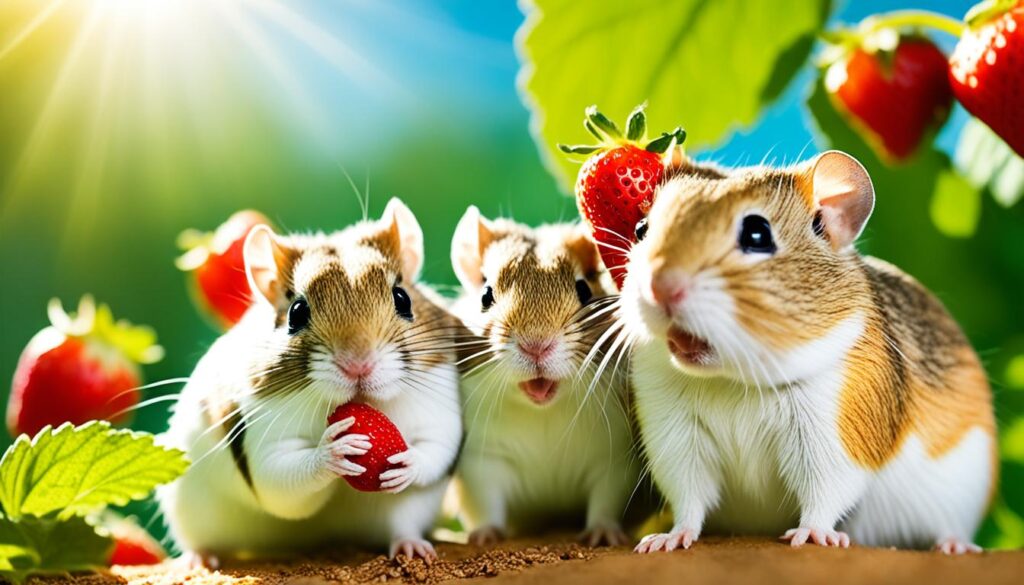
Can Gerbils Eat Wild Strawberries?
Gerbils can enjoy the deliciousness of wild strawberries, just like their store-bought counterparts. However, when it comes to introducing wild foods into your pet gerbil’s diet, there are a few important factors to consider. One of the potential risks is the presence of parasites or contaminants in wild strawberries.
It is crucial to wash wild strawberries thoroughly before offering them to your gerbils. This simple step helps reduce the likelihood of health issues and ensures that your furry friends can safely enjoy their wild strawberry treats.
Remember, taking precautions when feeding wild strawberries to your gerbils is essential to keep them healthy and vibrant. By keeping a watchful eye and being diligent in washing the wild strawberries, you can provide your gerbils with a taste of nature without compromising their well-being.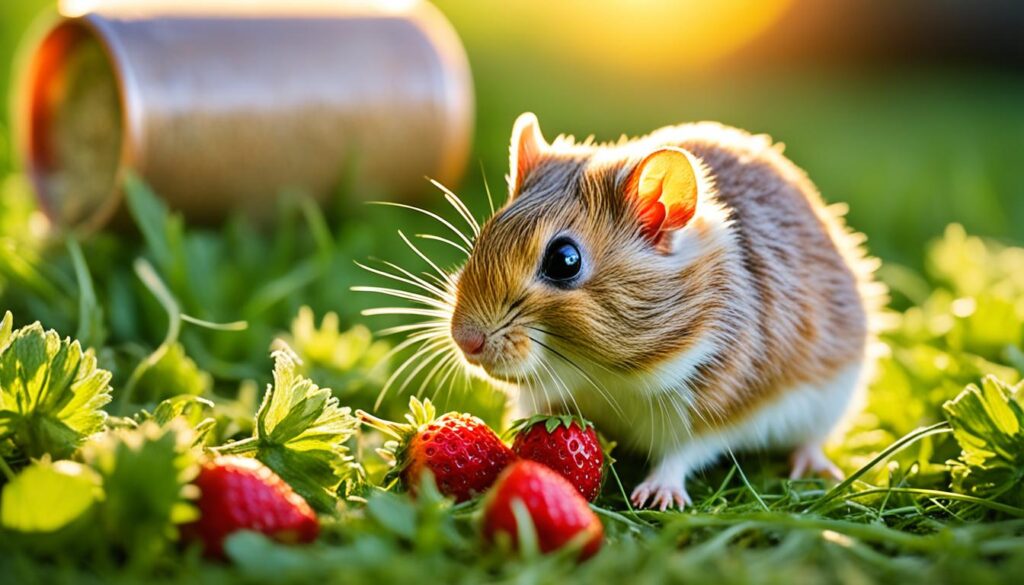
Benefits of Feeding Gerbils Wild Strawberries
Wild strawberries can offer similar nutritional benefits to store-bought strawberries for gerbils. These tiny fruits are packed with natural sweetness and refreshing water content, which are typically appealing to gerbils’ instinctual preferences for high-calorie and water-rich foods.
In addition to their enticing taste, wild strawberries can provide some diversity to your gerbils’ diet. While they may not be a significant source of essential nutrients, they do contain vitamin C, which can contribute to your gerbils’ overall well-being.
| Benefits of Wild Strawberries for Gerbils | Nutrient Content |
|---|---|
| Source of natural sweetness | High in vitamin C |
| Water-rich, hydrating snack | Low in calories |
| Provides variety in diet | Rich in antioxidants |
Can Gerbils Eat Frozen Strawberries?
Frozen strawberries can be a tempting and convenient option to offer your gerbils as a treat. These frozen fruits often have a similar nutritional content to fresh strawberries, making them a safe choice for gerbil consumption.
However, it’s important to consider the potential temperature-related issues that frozen strawberries can pose to gerbils. When gerbils consume frozen foods, it can cause a significant drop in their body temperature, which can lead to health problems.
To prevent any potential issues, it’s crucial to thaw frozen strawberries before offering them to your gerbils. Thawing the strawberries allows them to reach room temperature, ensuring that they are safe for consumption.
By allowing frozen strawberries to thaw properly, you minimize the risk of any temperature-related health concerns and provide a safe and enjoyable treat for your gerbils.
| Pros of Feeding Frozen Strawberries to Gerbils | Cons of Feeding Frozen Strawberries to Gerbils |
|---|---|
|
|
Do Gerbils Like Strawberries?
Gerbils are naturally attracted to the sugary taste of strawberries and often enjoy them as part of their diet. As animals that have evolved to seek out sweet and calorie-dense foods, gerbils find strawberries appealing. The aroma and vibrant color of strawberries can also pique their curiosity and make them eager to try this delicious fruit.

When offering strawberries to gerbils, you may notice their excitement as they nibble on the juicy goodness. It’s a treat that can bring joy and satisfaction to your furry friends.
However, it’s important to feed strawberries in moderation and as a treat rather than a regular part of their diet. While gerbils can enjoy strawberries, it’s crucial to maintain a balanced and healthy nutrition for them. Strawberries should not replace their staple diet of pellets, hay, and fresh vegetables.
“Feeding gerbils strawberries in moderation ensures they receive a diverse range of nutrients without overloading their systems with excessive sugar.”
Feeding gerbils strawberries in moderation ensures they receive a diverse range of nutrients without overloading their systems with excessive sugar. Too much sugar can lead to weight gain, dental problems, and digestive issues for gerbils. By offering strawberries as a special treat every now and then, you can provide a delightful and tasty experience for your furry companions.
Remember, variety is important in a gerbil’s diet, and strawberries can be a great addition to their culinary repertoire. Just be sure to introduce them gradually and observe their reaction and behavior. If your gerbil shows any signs of discomfort or adverse effects after consuming strawberries, it’s best to consult a veterinarian.
Benefits of Strawberries for Gerbils:
- Source of natural sweetness that satisfies their taste preferences.
- Contains vitamin C, which can provide some health benefits.
- Adds variety to their diet, preventing boredom and promoting mental stimulation.
Recommended Feeding Guidelines:
- Feed strawberries as an occasional treat, not as a daily staple.
- Offer small quantities of strawberries, sliced or mashed, to prevent overconsumption.
- Monitor your gerbil’s overall diet and ensure it remains balanced and nutritious.
- Introduce strawberries gradually to gauge your gerbil’s tolerance and preferences.
By following these guidelines, you can provide your gerbils with the joy of enjoying strawberries while ensuring their health and well-being. Remember, a happy gerbil is a healthy gerbil!
Health Benefits of Strawberries for Gerbils
While strawberries may not provide essential nutrients for gerbils, they do offer some benefits that can enhance their overall diet. One notable benefit is the presence of vitamin C in strawberries. Although gerbils do not have a specific dietary requirement for vitamin C, this nutrient can still contribute to their well-being.
Additionally, strawberries appeal to gerbils due to their natural sweetness and high water content. These characteristics align with gerbils’ instinctual preferences for calorie-dense, water-rich foods. By offering strawberries as occasional snacks, gerbil owners can introduce variety to their pets’ diet and keep them engaged and satisfied.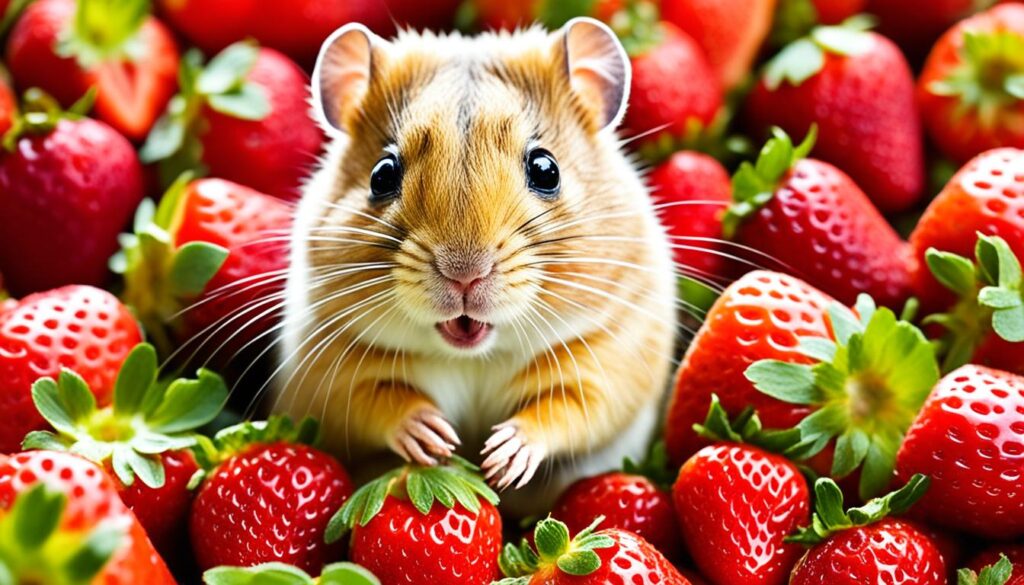
“Strawberries provide gerbils with vitamin C and a natural sweetness that appeals to their preferences for high-calorie and water-rich foods.”
How Much Strawberry Can Gerbils Eat?
When it comes to feeding strawberries to gerbils, portion control is key to ensuring their well-being. Offering small quantities of strawberries, either sliced or cubed, helps prevent overconsumption and potential health issues. By limiting strawberry intake to once or twice a week, gerbils can enjoy this tasty treat without compromising their balanced and healthy nutrition.
Feeding gerbils strawberries in moderation not only prevents excessive sugar intake but also ensures that they receive a variety of nutrients from other foods in their diet. It’s important to remember that strawberries should be viewed as occasional treats rather than a regular part of their daily feeding routine.
| Portion Size | Frequency |
|---|---|
| Small quantities, sliced or cubed | Once or twice a week |
By following these recommendations, you can provide your gerbils with the joy of enjoying strawberries while maintaining their overall well-being. Remember to observe your gerbils’ behavior and adjust the portion size accordingly.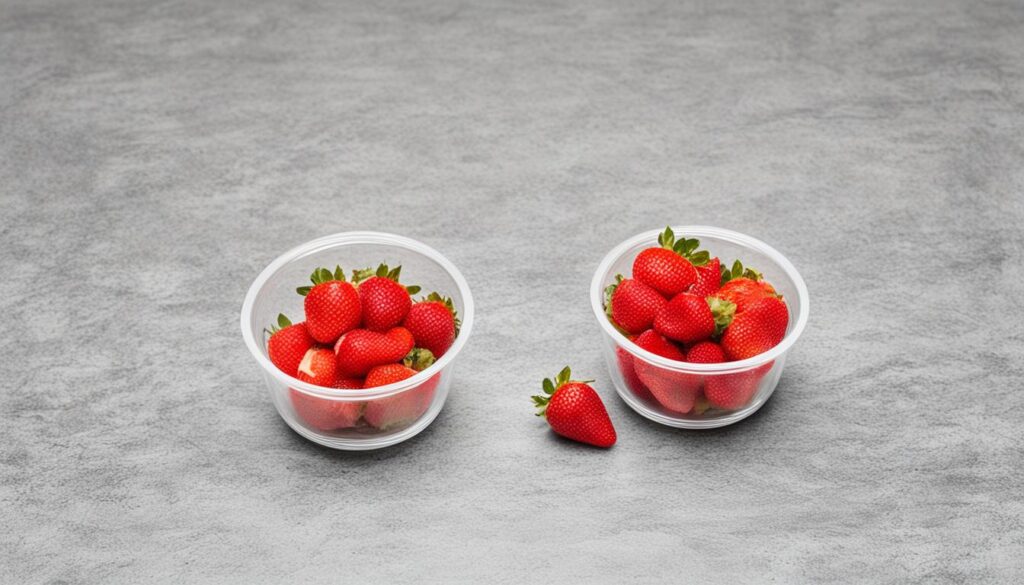
How Often Should Gerbils Eat Strawberries?
Gerbils absolutely adore strawberries, but it’s important to remember that these sweet treats should only be given to them occasionally. Feeding gerbils strawberries too frequently can disrupt their overall nutritional balance and potentially lead to health issues. As responsible gerbil owners, we must prioritize a well-rounded diet that meets all their dietary needs.
Strawberries are considered “empty calories” for gerbils, meaning they don’t provide significant nutritional value. While they do contain some beneficial nutrients like vitamin C, it’s crucial to remember that gerbils do not have a specific dietary requirement for this vitamin. Therefore, it’s best to think of strawberries as a special indulgence rather than a staple in their diet.
Limiting strawberry consumption to once or twice a week is a good guideline to follow. This allows gerbils to enjoy the taste and texture of strawberries without overdoing it. By keeping strawberry treats in moderation, we can ensure that our gerbils maintain a healthy and balanced diet.
Remember to monitor your gerbils’ reaction and behavior after feeding them strawberries. If you notice any digestive issues or changes in their overall well-being, it’s best to reduce or eliminate strawberry treats from their diet entirely. Every gerbil is unique, and it’s essential to pay attention to their individual preferences and sensitivities.
Let’s prioritize our gerbils’ health and well-being by offering strawberries as occasional treats, adding variety to their diet, and keeping their nutritional needs in mind.
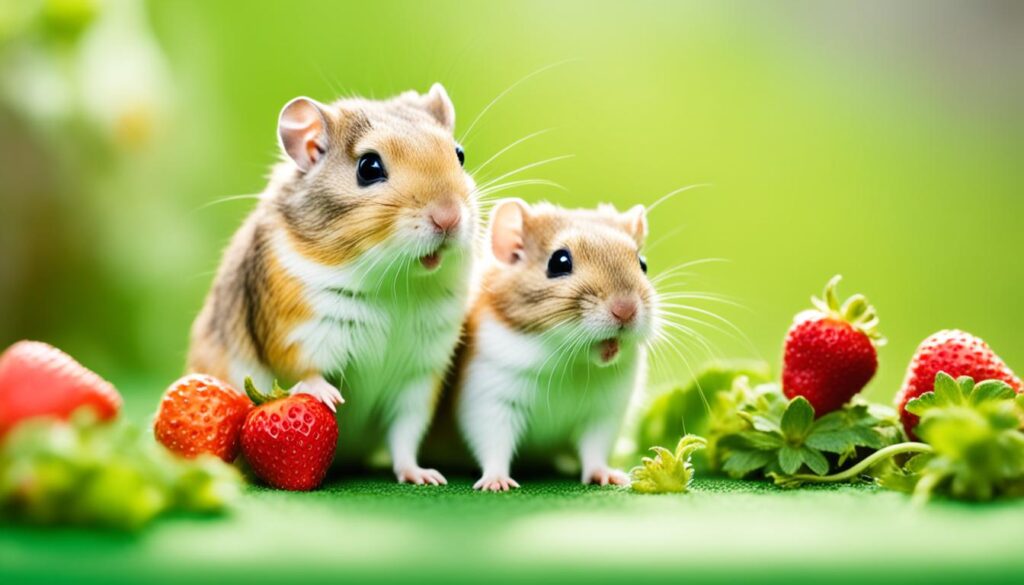
How to Feed Gerbils Strawberry
When it comes to feeding gerbils strawberries, it’s important to take a cautious approach to ensure their well-being. By following a few simple guidelines, you can introduce strawberries to your gerbil’s diet safely and responsibly.
Quantity Matters: Introducing Strawberries in Small Quantities
Feeding gerbils strawberries is all about moderation. Offer them small quantities of strawberries to prevent overconsumption and potential health issues. Sliced or cubed strawberries are easier for gerbils to eat and can help control portion sizes.
A Clean Environment: Feeding Strawberries in a Run or on a Plate
Provide a clean environment for your gerbil to enjoy their strawberry treat. Consider offering strawberries on a clean plate or in a specially designed run to prevent the food from getting dirty. This ensures the freshness and cleanliness of the strawberries, promoting the overall health of your gerbil.
Observation is Key: Monitoring Gerbil’s Reaction and Behavior
After feeding strawberries to your gerbil, take the time to observe their reaction and behavior. This allows you to ensure they are enjoying the treat and not experiencing any negative effects. If you notice any unusual behavior or digestive issues, discontinue offering strawberries and consult a veterinarian.
Pro Tip: Always introduce new foods gradually and monitor your gerbil’s response. Each gerbil is unique, and some may have different tolerances or preferences when it comes to strawberries or other treats.
| Benefits | Risks |
|---|---|
|
|
Conclusion
In conclusion, gerbils can enjoy strawberries as a rare and special treat in their diet. While strawberries provide some benefits, such as a source of vitamin C, it is crucial to feed them in moderation and alongside a balanced nutrition plan. We must be mindful of potential risks like gastrointestinal issues and excessive sugar intake, and prioritize the overall well-being of our gerbils.
By offering strawberries in small quantities and monitoring their reaction, we can ensure that our pet gerbils lead healthy and happy lives. It’s important to remember that strawberries should only be given as an occasional treat and not as a regular part of their daily meals. We should always consider their dietary requirements and focus on providing a diverse and nutritious diet for their optimal health.
So, the next time you want to treat your gerbil to something special, a small piece of strawberry can bring joy and variety to their diet. Just remember to keep it in moderation and observe how your furry friend responds. With a responsible approach to feeding gerbils strawberries, we can maintain their well-being and enhance their overall quality of life.FAQ
Can gerbils eat strawberries?
Can gerbils eat strawberry leaves?
Can gerbils eat wild strawberries?
Can gerbils eat frozen strawberries?
Do gerbils like strawberries?
What are the health benefits of strawberries for gerbils?
How much strawberry can gerbils eat?
How often should gerbils eat strawberries?
How to feed gerbils strawberries?
As our Editor-in-Chief, James plays a pivotal role in ensuring the quality and integrity of our content. With a keen eye for detail and a passion for storytelling, James oversees the editorial process here at A Place for Animals. With years of experience in content editing, James ensures that every piece of content meets our high standards of accuracy and clarity. Under James’ guidance, you can rest assured that the content you read is informative and impeccably crafted.
-

 Vetted2 months ago
Vetted2 months ago15 Best Cat Foods for Managing Hyperthyroidism – Vet Approved and Feline Friendly
-

 Vetted2 months ago
Vetted2 months ago15 Best Dog Foods for Kidney Disease – Expert Recommendations for Your Pet's Health
-

 Vetted2 months ago
Vetted2 months ago15 Best Fresh Dog Food Delivery Services for Your Pup's Health and Happiness
-

 Animal Facts2 months ago
Animal Facts2 months agoSpring Animals: A Guide to Seasonal Wildlife
-

 Cats1 month ago
Cats1 month agoCat Weight Chart by Age: Kitten to Senior in Lbs
-
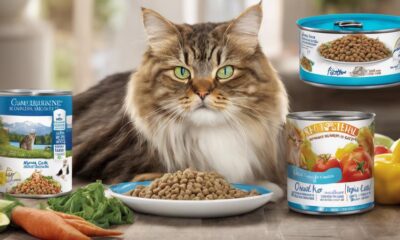
 Vetted2 months ago
Vetted2 months ago15 Best Wet Cat Foods for Older Cats to Keep Them Healthy and Happy
-

 Vetted2 months ago
Vetted2 months ago14 Best Homemade Dog Food Recipes Your Pup Will Love – Vet Approved & Nutritious
-

 Cats1 week ago
Cats1 week agoTop 5 Cat Breeders in Arkansas: A Guide






















